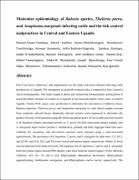| dc.description.abstract | East Coast fever, babesiosis, and anaplasmosis are the major tick-borne diseases affecting cattle productivity in Uganda. The emergence of acaricide-resistant ticks is suspected to have caused a rise in hemoparasites. This study sought to detect and characterize hemoparasites among farms in acaricide-failure hotspots of central as compared to the acaricide-failure naïve areas in Eastern Uganda. Nested PCR assays were performed to determine the prevalences of Babesia bovis, Babesia bigemina, Theileria parva, and Anaplasma marginale in cattle blood samples sourced from randomly selected farms. Randomly selected isolates were sequenced to determine the genetic diversity of the parasites using the following marker genes: B. bovis spherical body protein 4, B. bigemina rhoptry-associated protein 1a, T. parva 104 kDa microneme-rhoptry antigen, and A. marginale major surface protein 5. Furthermore, partially and fully engorged adult ticks were collected for taxonomy, and tick-control practices were assessed using a semi-structured questionnaire. The prevalence of B. bigemina, T. parva, and A. marginale in cattle were 17.2, 65.1, and 22.0%, and 10.0, 26.5, and 3% in the central and eastern region, respectively. Whilst, B. bovis was not detected in the farms involved. The sequences for B. bigemina, T. parva, and A. marginale from the central region showed 99% identity with those from the eastern region. Of the 548 ticks collected, 319, 147, 76, and 6 were Rhipicephalus (Boophilus) decoloratus, Rhipicephalus appendiculatus, Amblyomma variegatum, and Rhipicephalus evertsi evertsi, respectively. The
Rhipicephalus ticks were more abundant in the central region, whereas A. variegatum ticks were more abundant in the eastern region. Tick control malpractices were found in both Central and Eastern Uganda, and 42 of the 56 surveyed farms lacked appropriate restraining facilities and so they utilized either ropes or a ‘boma’ (enclosure). In summary, B. bigemina, T. parva, A. marginale and their co-infections were more prevalent in the central than eastern region; even though, tick control malpractices were observed in both regions. Therefore, an urgent tick and TBD control strategy is needed. | en_US |


